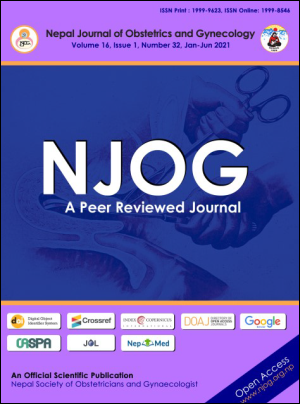Histological analysis of the products of conception in first trimester spontaneous abortions
Keywords:
abortion, histopathology, hydropic changes, molar pregnancyAbstract
Aims: To evaluate the histopathological findings of products of conception in the first trimester spontaneous abortions.
Methods: A hospital based descriptive cross sectional study conducted from March 2018 to March 2019, among the women admitted with diagnosis of first trimester spontaneous abortion at Paropakar Maternity and Women’s Hospital.
Results: Among 80 cases of spontaneous abortions, incomplete abortion was the commonest type constituting 42.5% of the studied group. The majority of participants belonged to age group of 21-30 years (61.2%) with a mean age of 26.8±6.1 years. Histopathologic examination confirmed products of conception in 60 (75%) patients, partial molar pregnancy in 9 (11.25%) patients, decidual reaction in 9 (11.25%) patients and hydropic abortus in only 2 (2.5%) patients. The molar pregnancy was more prevalent among women of Tibeto-Nepalese ethnic group 26.5% (n=9). Partial hydatidiform mole was more common in primiparous (19.3%) than in multiparous (14.2%).
Conclusions: The histopathological examination of the products of conception proved to be an important tool in detecting undiagnosed pathology like molar pregnancy and hydropic changes that necessitate special follow-up protocol and further management.
Downloads
Downloads
Published
How to Cite
Issue
Section
License
Copyright (c) 2021 Poonam Lama, Jitendra Pariyar

This work is licensed under a Creative Commons Attribution-NonCommercial 4.0 International License.
Copyright on any research article in the Nepal Journal of Obstetrics and Gynaecology is retained by the author(s).
The authors grant the Nepal Journal of Obstetrics and Gynaecology a license to publish the article and identify itself as the original publisher.
Articles in the Nepal Journal of Obstetrics and Gynaecology are Open Access articles published under the Creative Commons CC BY-NC License (https://creativecommons.org/licenses/by-nc/4.0/)
This license permits use, distribution and reproduction in any medium, provided the original work is properly cited, and it is not used for commercial purposes.



